#Metra Electric
Explore tagged Tumblr posts
Text
:3








There's a stairway to heaven and a highway to hell, but the midnight train goes anywhere. Trains are clearly the superior transit method.
#trainposting#amtrak#electric traction#south african railways#Iowa Interstate Railroad#pennsylvania railroad#milwaukee road#southern pacific#illinois central#south shore railroad#metra Electric
80K notes
·
View notes
Video
youtube
Metra 40th Anniversary Museum at the Metra Electric Randolph Station
#youtube#Chicago#Illinois#Metra#railroad#commuter railroad#railroad history#suburbanliving#40th Anniversary#1984#diesel locomotive#chicago and north western#rock island railroad#milwaukee road#Burlington Route#Burlington Northern#Illinois Central#Metra Electric
0 notes
Text
chicago Union station tell me what track to expect my train on please. Please. oh my god.
#There's literally electric signs that COULD tell me next to each track but all they say is congrats to metra for 40 years#It doesn't get here until 1:05 so there's time to find out but still oh my god
2 notes
·
View notes
Text




Art Institute Lion visits other Chicago landmarks
#the lincoln park zoo#zoo#metra electric train#oz park#the wizard of oz#winter garden#harold washington library#chicago#travel#toys#plush#lions
4 notes
·
View notes
Note
1500 Volt DC overhead power?










Train? :3










Choo choo!!!!
I love trains :D
#trainposting#electric traction#link light rail#Mexico city metro#south shore railroad#illinois central#metra electric
21 notes
·
View notes
Text
Homewood Metra Station To Close During Stairway Replacement | Homewood, IL Patch
#Metra-Electric#Homewood#Illinois#closed#stairs#renovation#construction#elevator#service#Calumet#Flossmoor#three-months
0 notes
Video
youtube
Metra Electric Holiday Train... followed by a regular train #christmastrain
#youtube#Chicago#Illinois#Metra#Metra Electric#holiday train#Grant Park#commuter rail#railroad#italo balbo#Museum Campus#balbo#plain train#Christmas#Christmas lights#Snowman#santa claus#flashing lights#train signals
0 notes
Text
Mapping/Routing the CTA
I'm still blaming @copperbadge for all of this.
As I am taking this trip in my mind, I have chosen to ignore a lot of the challenges the physical world brings. Like road construction, neighborhood block parties, day of the week, trains that only stop there once a day in the opposite direction, buses that only run a few hours a day, the actual passage of time, etc. This trip should not be attempted in the Real World – every route and stop apparently still exists, but you might need to wait hours if not days for the correct bus/train. For the Extra Bonus Points of LOLs and Nostalgia I have included sections of the Metra (Milwaukee Districts North and West and South Shore Electric), Big Bus Tours, and the Water Taxi.
Again, do NOT try this route in Real Time. Yet. My ADHD brain may or may not get back to you in a few days on how long it would actually take just so we can all laugh at the idea of getting lost and being forced to sneak around and spend the night in a mattress store at the Golf Mill Shopping Center or whatever. (Actually, that’s a hell of a meetcute. I… I might need to go write something now….)
Starting at Linden.
Ride Purple Line to Howard. Transfer to Yellow Line.
Ride Yellow Line to Dempster-Skokie. (Resist the muscle memory to catch the bus all the way to Deerfield. I really hated that commute.)
Bus to Morton Grove Metra.
Ride (MN) Metra to Mayfair.
Walk to Blue Line (Montrose). Ride Blue Line to O’Hare.
Stretch legs and bathroom break. Refill water bottle. Refuel if needed.
Ride Blue Line back to Harlem. Bus to Fullerton.
Walk around my old neighborhood. (I think the walk to Caputo’s is worth it, but maybe don’t buy any fresh squid if you’re getting back on the train.)
Ride (MW) Metra from Mont Clare to Grand/Cicero.
Bus to Blue Line (Montrose). Ride Blue Line to Forest Park.
Bus to Green Line (Harlem/Lake). Ride Green Line to Cottage Grove. (I’m stopping along the way to visit family, get something to eat, and maybe nap while charging my electronics.)
Bus to Green Line (Ashland/63rd). Ride Green Line to Garfield.
Walk to Red Line (Garfield). Ride Red Line to Dan Ryan. Hang Around Like An Idiot. Ride Red Line to Lake.
Transfer to Pink Line. Ride Pink Line to Cermak/54th, then back to Cicero.
Bus to Midway. (Unhydrate. Rehydrate.) Ride Orange Line to Halsted. Walk to River. Or I think there’s a bus that’s just not showing up at the moment.
Water Taxi to West Loop.
Walk to Willis Tower. (Bonus point for each instance of calling it Sears Tower.) Tour Bus to Museum Campus.
Metra Electric back to Millennium Park Station.
Walk to Washington/Wabash. Ride Brown Line to Kimball.
Ride Brown Line back to State/Lake. (Stop at Fullerton if it’s morning. Walk to Orange and order the pancake flight and watch them fresh squeeze your citrus juice. Walk to Molly’s if you like cupcakes. Double Extra Bonus points if you pointedly reminisce about the Meatloaf Bakery when you pass where it was. Crash a wedding at my old apartment building if you’re really bored. I really miss my neighborhood at the moment.)
Transfer to Red Line. Ride Red Line to Howard. (I’m going to stop at Granville for the Memories. This was my first address in Chicago – even if I technically wasn’t supposed to receive mail because I wasn’t on the lease.)
#this is not the route my protagonists will travel in my new novel#but it's kinda close#i really miss chicago#but it's just like so far from my ocean#and the lake is NOT the same#i also really miss my ocean#I think some novel drafting is in my future#writing is hard yo#please feel free to take the take the writing prompt and run with it#new trope: there were only 27 beds
65 notes
·
View notes
Video
IC No 6058 at University Park by Craig Sanders Via Flickr: I'm standing on the boarding platform of the Metra Electric station in University Park, Illinois. An Illinois Central freight led by an SD40 is working on the main track. April 9, 1998
#cn#canadian national#ic#illinois central#1998#trains#freight train#history#university park#illinois
20 notes
·
View notes
Text






I put in my twitter bio a good while ago that I'd start "regular train builds coming soon", so today we're delivering on that promise with a new series: TTTT (The Thursday Twitter/Tumblr Train)! To start off: The EMD F40PH, my first stab at a diesel electric in MC, complete with Metra gallery cars
#trains#mc builds#Metra#I'll probably change the watermark at some point lmao#mc shaders#minecraft trains
11 notes
·
View notes
Text
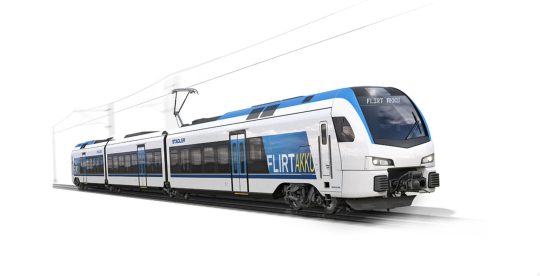
Well! Some great news on Metra electrification - they’ve issued a procurement order to Stadler for all-new battery-electric trains - most likely the FLIRT Akku, which is easily convertible for dual battery / overhead catenary operation.
The order (PDF) at Metra
3 notes
·
View notes
Text
Interesting a Married Pair with a front door










As you can see all these married pair Multiple Units have a door located on the face of each cab to facilitate movement between each unit
Also get some model trains

鉄コレ遠州鉄道2000形入線。
#trainposting#long island railroad#denver rtd#septa regional rail#nj transit#mta metro north#illinois central#metra electric district#electric traction#electric train
49 notes
·
View notes
Text


I miss doing longform project writeups here; it's been a while! I recently replaced the old stock stereo in my 2009 car with a modern system (nothing fancy, just a super basic bluetooth stereo because I was tired of not having the AUX cable adapter for my phone since phone manufacturers decided to hamstring the world's phone users by removing AUX jacks).
It came out surprisingly affordable to upgrade, at $62 total! After-tax cost breakdowns:
Bluetooth stereo: $23
DIN dash trim (Metra brand): $20
Radio wiring harness (also Metra): $10
Antenna wiring harness (optional): $9
Replacing an older stereo is theoretically straightforward, but annoying in practice because you have no idea what you need until you actually open up the car and realize you were supposed to buy another simple part they didn't tell you about. I got mad and wrote this post up because I had already yanked the old stereo out of my car before realizing I was supposed to buy a wiring harness, and then my car dash had a big hole in it for a few days while I waited for it to ship.
What you need to wire up an aftermarket stereo:
The stereo kit, which should come with plugs that are compatible with the stereo itself
"Dash trim kit": the molded plastic piece on your dashboard that components are mounted into. It should be made for your particular car. This is only necessary if your new stereo mount is different from your old stereo mount.
"Radio wiring harness" (connects stereo to power & speakers) and "antenna wiring harness" (if you also want radio reception). These are sockets matching the proprietary connectors for the wires coming out of your car.I had to buy mine online because my car is 14 years old. If your car is newer then you may be able to find the parts at a local auto store.
Either soldering equipment (soldering iron, solder, electrical tape, wire stripper, and "helping hands"), or you pay someone else to install it for you, in which case you probably aren't reading this post lol
(My new stereo conforms to the "single DIN" dimension standard. DIN sizing is blessedly standardized across cars. Single DIN is the smaller size that lets you install a little snack compartment or drawer beneath your stereo, and double DIN is the bigger size that's usually used for a touchscreen.)
You probably can't just buy a single cable that will connect your new stereo directly into your car, for many reasons. Car manufacturers are based all over the world, and cars in general are extremely non-standardized. Different cars and stereos all use different plugs, and it would be too difficult for each stereo manufacturer to provide a different wiring harness for every possible car model out there.
Also, it is beneficial for every electrical connector in your dash region to be shaped differently, so that you can't accidentally plug it into the wrong socket. At first I was annoyed to see five totally different proprietary connectors when I opened up the dash, but after failing to label three of them, I was very glad that they were all different shapes.
So unless you wanna sit in your car soldering your stereo directly to your car with no takebacks, you probably want to make yourself that custom stereo<>car cable by getting the radio wiring harness & antenna wiring harness that fit your car model, then soldering them to the cable that came with your stereo kit. Thankfully my cables seemed to come with a standardized coloring scheme for the wires, so it was easy to match them up.
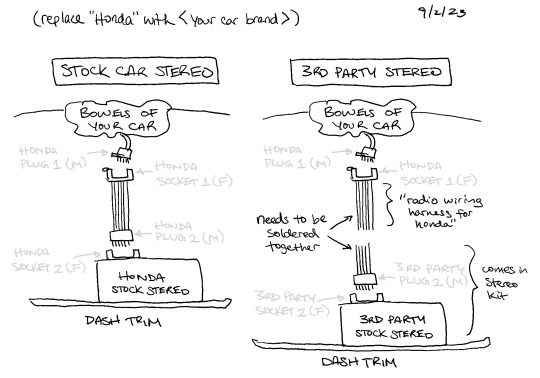
Tools you need to replace your old dash & stereo (I winged it with whatever was in my toolbox...but most people have fewer tools than me)
Either an auto trim remover kit, OR two small pry bars, a flathead screwdriver, and something long and flat such as a butter knife for leverage
Philips screwdriver -- a ratcheting one is helpful, but not required
Any additional tools as recommended by your car's service manual (or friendly local Youtube). For example, my car's service manual called for an 8mm socket wrench with a 6" extender to remove a bolt securing the stock radio.
Having two mini pry bars was helpful for taking off the retaining clips without breaking them. They are very fiddly.
Also, my stereo felt slightly wobbly in its thin sheet metal mount. So I stuffed a bit of cardboard between the stereo and the snack compartment as a makeshift shim, and am just crossing my fingers that something so close to the back of the engine won't catch on fire. Maybe the proximity to the AC helps.

3 notes
·
View notes
Text
Van Buren Street Station, Chicago
1896, Francis T. Bacon, Supervising Architect of the Illinois Central Railroad system
John F. Wallace, Chief Engineer
J.L. Fulton Company, General Contractors

Van Buren Street Station, platform level view
The Van Buren Street Station, 132 E. Van Buren at Michigan Avenue, is a commuter rail station in downtown Chicago serving the southbound Metra Electric Line, as well as the South Shore Line to Gary and South Bend, Indana.. It is the oldest active station building on the Metra Electric line. The station is located in Grant Park to the east of Michigan Avenue at Van Buren Street.
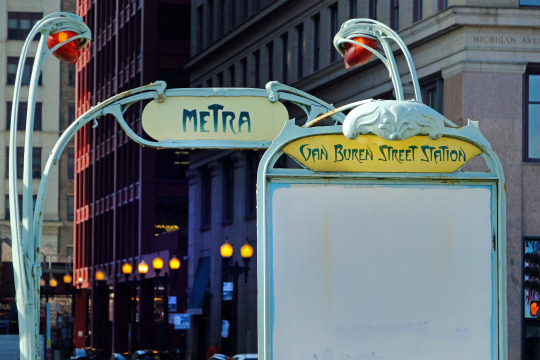
One of the station's entrances is a replica of an Hector Guimard-designed, Art Nouveau-style Paris Métro entrance. The entrance was given to Chicago as a gift by the city of Paris in 2001. The Guimard entrance will be relocated as part of a station renovation to be completed by 2027.
The station was originally constructed by the Illinois Central Railroad (incorporated 1836; operated independently until 1972), and completed in 1896.

Vintage view of the station, with buildings of Michigan Avenue behind.
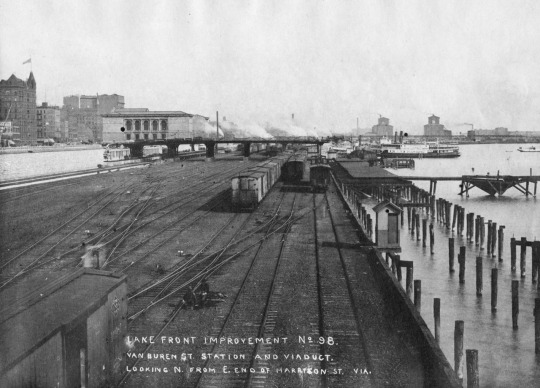
"Lake Front Improvement No. 98. Van Buren St. Station and Viaduct. Looking N. from E. end Harrison St. viaduct."
The Van Buren Station is the first Metra stop south of the Millenium Station, the northern terminus of the South Shore Line.
The station is completely invisible from the street, constructed below grade, one level below Grant Park. From Michigan Avenue, passengers descend stairs to a long, featureless tunnel about a block long, which splits into up and down ramps that easily confuse the visitor, and are inadequately labeled for the ticket office and main level, or down toward Platform 2 access.
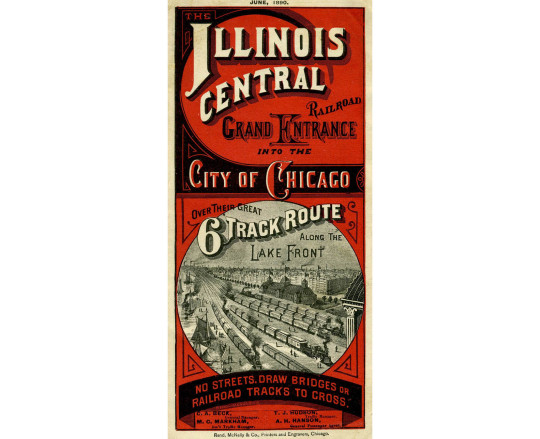
I saw the Van Buren Street Station for the first time when I took a train to Hyde Park, and decided not to depart from Millenium Station, which can be a confusing space to navigate. Nothing prepared me for this underground slice of history, and its largely intact tile and terra cotta waiting areas.

The station is below the level of the park, only its roof surrounded by a balustrade visible from above. The pedestrian viaduct over its center leads to the eastern side of Grant Park and the Lincoln statue. Entrances are from the sidewalk on the west side of Michigan Avenue, and from the Guimard Paris metro and stairs at "Van Buren Entrance" in the screencap above.

The station's placement is illustrated in the above plan, in The Inland Architect and News Record, Vol. XXIX No. 1, February 1897, Special Supplement p. 2.

The station's plan (above) and section (below) were also reproduced in the 1897 Inland Architect.
"Francis T. Bacon was the supervising architect of the Illinois Central Railroad system from the mid-1890s until 1907. Bacon died in Chicago on June 18, 1909, at the age of 43, after having been in private practice for two years." - Wikipedia entry
The Engineering Record, Building Record and Sanitary Engineer, Volume 60, 1909, cited in the wikipedia entry, doesn't reveal any further details of his life.

In this section, the station wall is heavily buttressed on the left, under the ground of Grant Park. A balustrade surrounds the ground-level roof, and the train platform is at right.
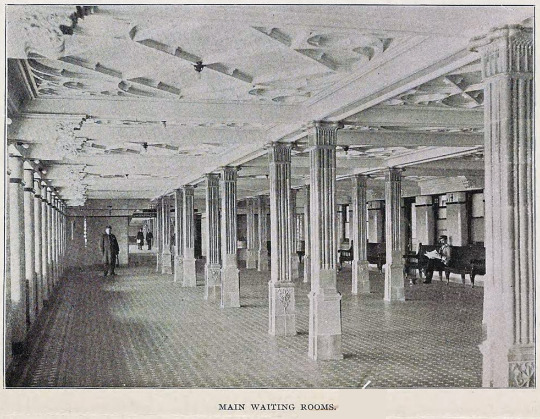
A glowing contemporary description of the station from The Inland Architect details the Waiting rooms' features and construction materials:
After passing the ticket inspectors, those taking express trains turn to the right and those for local trains to the left, in the central distributing corridor. From this corridor the passengers are ushered into two magnificent waiting rooms, each 34 feet by 106 feet and 9 ½ feet high. These rooms, for beauty, substantiality and completeness of appointments and conveniences, will compare favorably with those of any railway station in the world, even though naturally restricted in height of ceiling. The floors of the wating and toilet rooms, also corridor, are all paved with English floor tile; the foyer, vestibule and south entrance are paved with ceramic mosaic, and the bas throughout is of polished Tennessee marble. The walls are faced with Maw’s écru glazed tile, 3 by 6 inches, patented lock back, and the ceilings are of cast plates of stucco, forming a design of Gothic tracery. The cornices and girders and also finished in stucco, the point of junction with the glazed tile walls being covered with a mahogany molding. There are two rows of cast-iron columns in each room, which are incased in écru glazed terra cotta, elaborately molded and ornamented.
The windows of the ticket offices are covered with elaborate, handmade, wrought-iron grilles, some of which are polished and electroplated with bronze.
Source: The Inland Architect and News Record, Vol. XXIX No. 1, February 1897, Special Supplement p. 2
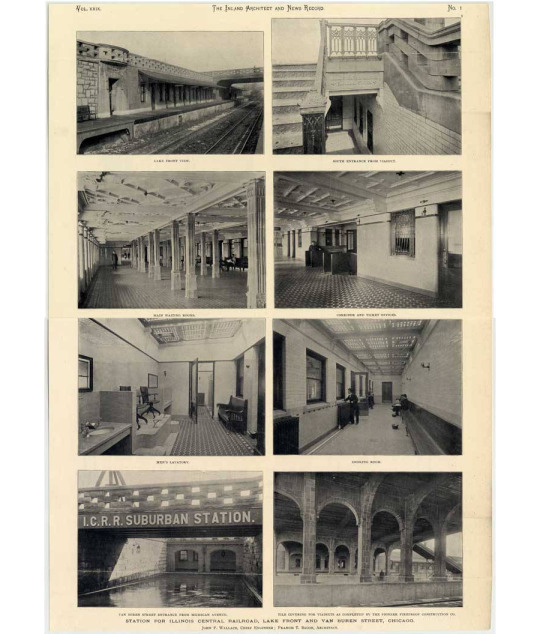
The station originally featured, apart from two waiting rooms, smoking rooms, a ladies' retiring room and lavatory, and a matron's room at the south end of the building.
The men's lavatory, bootblacking stand, toilet and janitor rooms are at the north end. There are also private lavatories for the attendants and locker rooms for the railroad employees. All these are under the space of 14 feet wide and 300 feet along the park side, and already occupied by the entrances, and are lighted through ceilings of cast iron and glass.
Source: The Inland Architect and News Record, Vol. XXIX No. 1, February 1897, Special Supplement p. 2
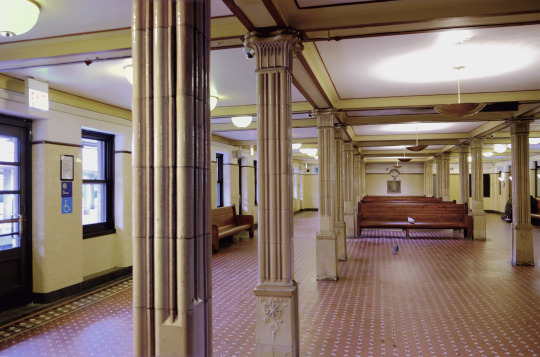
The tiles on the walls were manufactured by Maw & Co., of Shropshire, England, and are supplied and set by their agents, Hawes & Dodd, of this city, and are chiefly remarkable for their evenness of color, highly finished glaze, and freedom from the technical fault known as "Crazing."
Source: The Inland Architect and News Record, Vol. XXIX No. 1, February 1897, Special Supplement p. 2

The Inland Architect article also noted the building's fireproof construction, including terra-cotta-clad iron columns, and that the entire interior was washable.
Not all of the station's original features remain. The cast-plaster ornamental ceiling is long gone, as are some of the more elaborate decorative elements, such as scrolled wall brackets and an ornamental drinking fountain shown in a period photo below.

No trace remains of the original marble and bronze recessed drinking fountains or decorative brackets above.

The column bases and bright inlaid flooring, in need of some restoration, are still in place.

The tilework remains intact, but the original ornamental ceiling has been replaced, as well as some other decorative elements.

Original mahogany waiting-room furniture includes this curved corner bench. The benches have brass feet, to facilitate cleaning the floors.

Detail of ornamental floor tile work at the edge of one waiting room

The ticket windows are located in the entrance vestibule leading to the twin waiting rooms.

Van Buren Street Station in 1907; exit stairs from middle platform to the Van Buren viaduct

"The east front of the building, 300 feet in length, shows a wall of one story, faced with cut Bedford stone - pierced with windows and doors." (Inland Architect)
The original awning over the platform was replaced, and is in a state of disrepair.
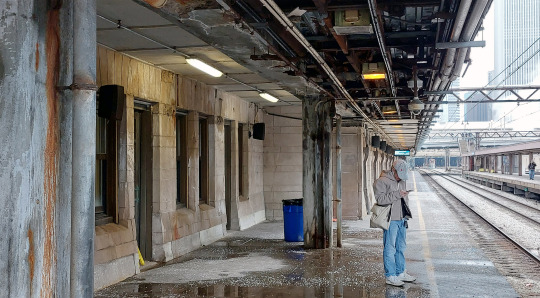
The recessed central area of the platform is directly underneath the Van Buren viaduct above.

The exterior still features carved stone decorations.
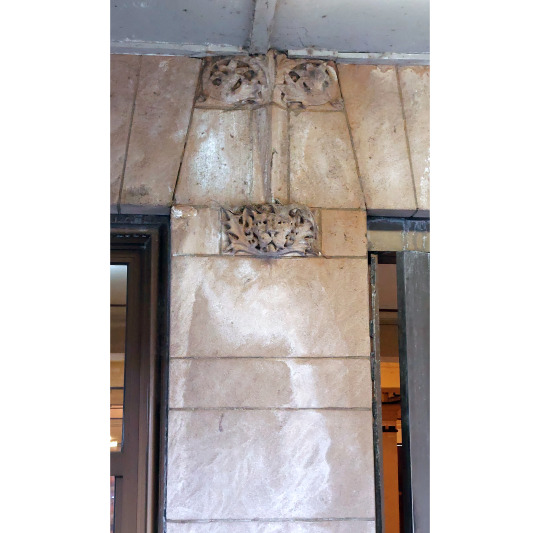
Detail of one of the carved stone elements.

"...even the copper down-spouts and their open heads are veritable works of art." ( Inland Architect)

At the far north end of the second platform, stairs allow passengers to exit to the Jackson Blvd. overpass, just south of the Art Institute.
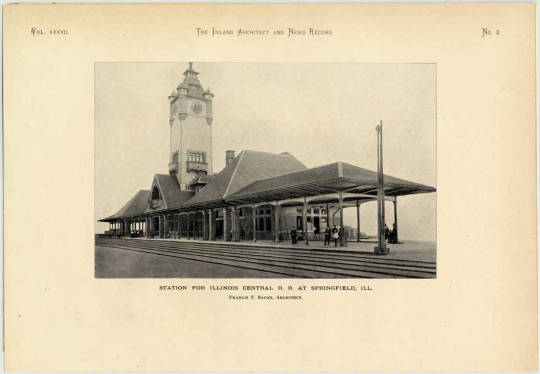
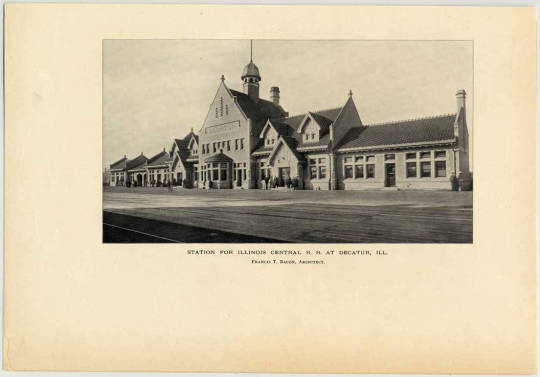
Other Illinois stations designed by Francis T. Bacon:
Left:
Illinois Central (IC) Railroad Station, Springfield, Illinois; Springfield Union Station, 500 E. Madison St., 1896-98; 1901 view, The Inland Architect
Right:
Illinois Central (IC) Railroad Station, Decatur, Illinois, c. 1890s; View 1901, The Inland Architect

The center or second platform gives access to northbound trains. It's reached by stairs or elevator below the main station.
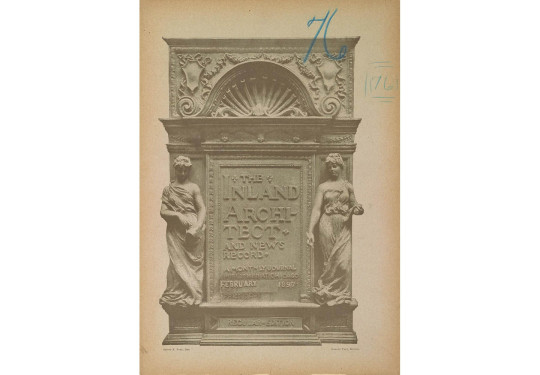
Click here for a PDF version of The Inland Architect v 29 no 1 of Feb. 1897 article on the Van Buren Station.
Links:
6 notes
·
View notes
Text
Rating Museums Transit Access:
The Field Museum in Chicago is about an 8 minute walk from the Metra Electric Museum Campus Station, trains stop there every 5 minutes
8/10, 1 point deducted for requiring people to walk under a highway to get there

508 notes
·
View notes
Text
YES








the thing about me is that if you ever meet me in person you will find that i am extremely awkward and will probably try to show you wikipedia articles on my phone and tell you random things about trains and buses
174 notes
·
View notes